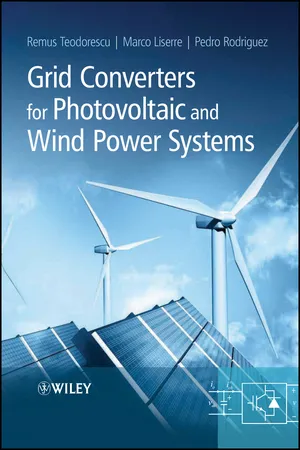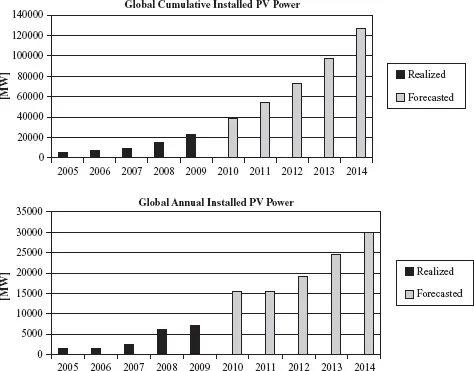![]()
1
Introduction
In the last few years renewable energies have experienced one of the largest growth areas in percentage of over 30% per year, compared with the growth of coal and lignite energy.
The goal of the European Community (the EU) is to reach 20% in 2020, but the EU-27 energy is only 17% of world energy. The US, with 22% of energy share, has adopted similar goals under the pressure of public opinion concerned by environmental problems and in order to overcome the economical crisis. However, the policies of Asia and Pacific countries, with 35% of energy share, will probably be more important in the future energy scenario. In fact, countries like China and India require continuously more energy (China energy share has increased 1 point every year from 2000).
The need for more energy of the emerging countries and the environmental concerns of the US and the EU increases the importance of renewable energy sources in the future energy scenario.
1.1 Wind Power Development
Grid-connected wind systems are being developed very quickly and the penetration of wind power (WP) is increasing.
The driving force in Europe was taken in March 2007, when EU Heads of State adopted a binding target of 20% of energy generated from renewable sources by 2020. A similar plan for 25% renewable energy sources until 2025 has been adopted in the US.
According to BTM Consult [1], the cumulative and annual installed wind power worldwide in 2009 is shown in Figure 1.1. Despite the economic crisis, 2009 was a very good year, with a worldwide installed wind power of 38.1 GW (35% higher than 2008). The biggest markets in 2009 were China, with 36.1%, and the US, with 26%. The cumulative worldwide installed wind power by the end of 2009 was 160.1 GW. The average growth for the period 2004-2009 was 36.1%, while the forecast average growth for the period 2010-2014 is 13.6% (reduced due to the economic crisis of 2008-2010). The worldwide cumulative installed power forecasted by 2019 is close to 1 TW, leading to a global wind power penetration of 8.4%.
Wind energy penetration (%) is defined as the total amount of wind energy produced annually (TWh) divided by the gross annual electricity demand (TWh). According to the EWEA (European Wind Energy Association) [2], the approximate wind energy penetration in Europe by 2008 was 3.8%, with the highest penetration levels of 21% in Denmark, 12% in Spain and Portugal, 9% in Ireland and 7% in Germany. At the regional level much higher penetration levels were achieved, as, for example, 36% in Schleswig-Holstein, Germany, and 70% in Navarra, Spain.
According to the DOE (US Department of Energy) [3], the wind energy penetration level in the US reached 1.9% by 2008, with highest state levels in Iowa 13.3%, Minnesota 10.4% and Texas 5.3%. The worldwide wind energy penetration by 2008 was 1.5%.
It is very difficult to define the maximum level of penetration as it is strongly dependent on the particularities of the grid in the considered area in terms of conventional generation, pricing, interconnection capacity, demand management and eventual storage capacity. Typically several regional or national grids are interconnected (as, for example, UCTE and NORDEL) and by agreement certain shared reserve generation and transmission capacity is provided in order to cope with n − 1 type contingency. The fluctuating wind power dispatch works also as a ‘disturbance’ in the system and this reserve capacity can also be successfully used for balancing purposes. Some studies have indicated that 20% wind penetration may be achieved without major transmission or storage developments. Electrical utilities continue to study the effects of large-scale (20% or more) penetration of wind generation on system stability and economics. Denmark has planned wind penetration of 50% by 2025 [4]. The Danish grid is strongly interconnected to the European electrical grid through Norway, Germany and Sweden. Almost half of its wind power is exported to Norway, which can easily balance its almost entirely hydro-based power system.
In order to be able to increase the wind energy penetration, new grid interconnection requirements called grid codes have been developed by countries with high penetration.
1.2 Photovoltaic Power Development
The worldwide cumulative and annual photovoltaic (PV) power installed according to EPIA are shown in Figure 1.2 [5].
The year 2009 was also a good year for PV, as 6.4 GW was installed (equivalent to approx one-sixth of wind power installed). From an empirical point of view we can say that PV is growing at approximately the same rate as WP and is just approximately 6 years behind. The forecast for 2014 is 30 GW for PV, close to the 28.7 GW for WP forcast 6 years ago (for 2008). The worldwide cumulative PV power reached 22.8 GW by the end of 2009.
Today, there are several PV parks with installed power > 40 MW in Spain, Germany and Portugal. The PV penetration is quite low now but it is estimated by EPIA that it could be as high as 12% in 2020.
Another important aspect is that the cost of PV panels have dropped during 2008 by around 40% to levels under € 2/W for PV. The bulk penetration of the PV system is expected around 2015 when the cost of PV electricity is forecasted to became compatible with the cost of conventional energy.
1.3 The Grid Converter - The Key Element in Grid Integration of WT and PV Systems
Power converters is the technology that enables the efficient and flexible interconnection of different players (renewable energy generation, energy storage, flexible transmission and controllable loads) to the electric power system. Hence it is possible to foresee how the synchronous machine has a central role in the centralized power system and the grid converter, also denoted as the ‘synchronous converter’, will be a major player in a future power system based on smart grid technologies. While the electromagnetic field has a major role in the synchronous machine, the grid converter is based mainly on semiconductor technology and signal processing but its connection filter, where the inductor is dominant, still has a crucial role to play in transient behaviour.
The increase in the power that needs to be managed by the distributed generation systems leads to the use of more voltage levels, leading to more complex structures based on a singlecell converter (like neutral point clamped multilevel converters) or a multicell converter (like cascaded H-bridge or interleaved converters). In the design and control of the grid converter the challenges and opportunities are related to the need to use a lower switching frequency to manage a higher power level as well as to the availability of a more powerful computational device and of more distributed intelligence (e.g. in the sensors and in the PWM drivers).
The book analyses both basic and advanced issues related to synchronization with the grid, harmonic control and stability, and at the system level in order to detect and manage islanding conditions for PV power systems and control under grid faults for WT power systems. It is intended for both graduate students in electrical engineering as well as practising engineers in the WT and PV industry, with special focus on the design and control of grid converters.
References
[1] BTM Consult, ‘World Market Update 2009 (Forecast 2010-2014)’, March 2010. www.btm.dk.
[2] EWEA, ‘Wind Energy - The Facts Executive Summary, March 2009’. http://www.ewea.org/fileadmin/eweadocuments/documents/publications/WETF/1565ExSumENG.pdf.
[3] US Department of Energy, ‘Wind Technologies Market Report 2008’, Prepared by the National Renewable Energy Laboratory (NREL), DOE/GO-102009-2868, July 2009. http://www1.eere.energy.gov/windandhydro/pdfs/46026.pdf.
[4] PSO ForskEL, ‘EcoGrid.dk, Phase I - Summary Report: Steps towards a Danish Power System with 50% Wind Energy’. R…D-Contract for Project 2007-1-7816, Funded by Energinet.dk. http://www.e-pages.dk/energinet/137/fullpdf/full4aab3e1a6ad8.pdf.
[5] EPIA, ‘Global Market Outlook for Photovoltaics until 2014’, May 2010. http://www.epia.org/fileadmin/EPIAdocs/public/Global Market outlook for Photovoltaics until 2014.pdf.
![]()
2
Photovoltaic Inverter Structures
2.1 Introduction
The PV inverter is the key element of grid-connected PV power systems. The main function is to convert the DC power generated by PV panels into grid-synchronized AC power.
Depending on the PV power plant configuration, the PV inverters can be categorized as:
- Module integrated inverters, typically in the 50-400 W range for very small PV plants (one panel).
- String inverters, typically in the 0.4-2 kW range for small roof-top plants with panels connected in one string.
- Multistring inverters, typically in the 1.5-6 kW range for medium large roof-top plants with panels configured in one to two strings.
- Mini central inverters, typically > 6 kW with three-phase topology and modular design for larger roof-tops or smaller power plants in the range of 100 kW and typical unit sizes of 6, 8, 10 and 15 kW.
- Central inverters, typically in the 100-1000 kW range with three-phase topology and modular design for large power plants ranging to tenths of a MW and typical unit sizes of 100, 150, 250, 500 and 1000 kW.
Historically the first grid-connected PV plants were introduced in the 1980s as thyristorbased central inverters. The first ser...


